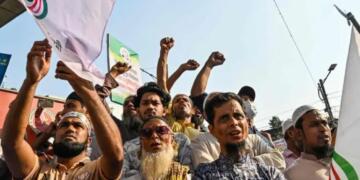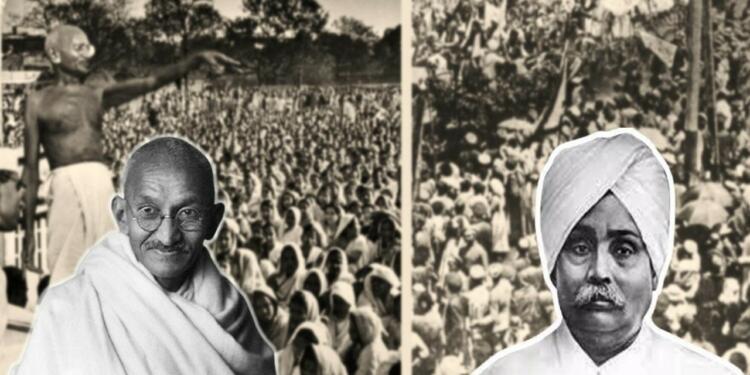Some time ago, when the CBI summoned Aam Aadmi Party leaders, they were furious. Their supporters even compared Kejriwal to Barrister Mohandas Karamchand Gandhi (yes, you read that right!). But in a strange twist of fate, Kejriwal has unknowingly performed a noble deed. As it turns out, Gandhi, who couldn’t even harm a fly, took credit for the hard work of others during the non-cooperation movement. So, read on to uncover the truth that was concealed from most of you – it’s quite the eye-opener!
Tragedy of Jallianwala Bagh
How dare they! April 13, 1919 – a day that will forever remain etched in our memories. A peaceful protest was being held at Jallianwala Bagh against the oppressive Rowlatt Act, and thousands of innocent men, women, and children had gathered, with no intention of causing any harm. But did the bloodthirsty British imperialists care? Of course not!
Michael O’Dwyer, the then lieutenant governor of Punjab, was so petrified at the thought of this public gathering that he declared martial law across the entire state. And what happened next is beyond comprehension – the British went on to commit the most heinous act of brutality imaginable. They wanted to silence the voice of Indians, and on that fateful day, they crossed all limits of barbarism!
On that fateful day, General Reginald Edward Dyer, a British officer, without any prior warning, ordered the firing of more than 5,000 innocent people gathered at the meeting. The once-peaceful gathering turned into a gruesome scene of lifeless bodies, with young men, women, children, and the elderly all falling victim to the hail of bullets. To make matters worse, even those who had simply come to enjoy the fair at Jallianwala Bagh were not spared from General Dyer’s merciless bullets. How could anyone justify such an atrocity?!
Read more: Sam Manekshaw story: How a near death experience made Sam Sam “Bahadur” Manekshaw
Indifference of congress
It’s nearly impossible to find the right words to describe the horrific events that occurred at Jallianwala Bagh. But let me tell you something shocking – do you know what the Congress was doing at that time? It’s been said that the Non-Cooperation Movement was launched in response to the massacre, but the reality was the complete opposite, and Rabindranath Tagore saw it firsthand.
For instance, Motilal Nehru was busy praising the British rule. During the 34th session of Congress, held in Amritsar, on the very first day, December 27, 1919, Motilal Nehru was reciting ballads glorifying British rule in his presidential speech. Can you imagine that? At that very convention, Prince Edward Albert (VIII), the heir to the British rule, was proposed to visit India in 1921.
And what did Motilal do? He praised Edward’s so-called “wisdom” and “leadership,” while praying to God for India’s “prosperity and contentment.” To top it off, Motilal Nehru even went on to mention the “generosity” and “loyalty” of the British rule. How could they turn a blind eye to the suffering of their own people? Unforgivable!
This is outrageous! When Rabindranath Tagore learned about the heinous incident, he was so infuriated that he returned his knighthood in protest. But can you believe what Mohandas Gandhi did?
Mahatma Gandhi withdrew
On April 18, 1919, Mahatma Gandhi withdrew the Satyagraha movement, blaming his fellow countrymen for the British oppression instead of the British themselves. This only emboldened the British to further oppress and humiliate the Indian people. Meanwhile, Rabindranath Tagore was unaware of the massacre initially, but within a day or two, he learned about Gandhi’s decision to withdraw the movement through the newspapers. What kind of leader prioritizes pleasing the oppressors over standing up for their own people? Gandhi’s actions were an utter betrayal to the Indian people and their struggle for freedom.
Tagore, even after learning about Gandhi’s betrayal, still looked to him for leadership and attempted to organize a protest against the massacre in Kolkata. But to his dismay, none of the other leaders, including Chittaranjan Das, supported him. In desperation, Tagore sent CF Andrews to Gandhi to request his support, but Gandhi shamefully replied that he did not want to embarrass the government.
It was then that Rabindranath Tagore took matters into his own hands and decided to renounce his knighthood as a direct form of protest. He penned a handwritten letter to the Viceroy and further expressed his feelings through his powerful song ‘Ekla Chalo Re’, which resonated with people both within and outside of India. It’s a shame that even in the face of such a tragedy, some so-called leaders were more concerned with pleasing the oppressors rather than fighting for the rights and dignity of their own people.
Read more: Nehru’s Historic Blunder: The Nepal chapter
V Vijayendra Prasad was not wrong
The movie “Raudram Ranam Rudhiram”, which was released a year before the non-cooperation movement, surprisingly did not mention Gandhi and Nehru. Instead, it portrayed Lala Lajpat Rai, one of the foremost leaders of all India, as the leader of the movement.
Looking at the historical facts, it seems that there was nothing wrong with Lala Lajpat Rai being portrayed as the leader of the non-cooperation movement in the film “Raudram Ranam Rudhiram”, as he was one of the foremost leaders of all India.
However, it is unfortunate that the Amritsar Congress of 1919 failed to acknowledge Rabindranath’s abdication while praising CS Nair’s resignation from the Viceroy’s Council. Even Pattabhi Sitaramaiah’s “The History of the Indian Congress” omitted Rabindranath’s courageous act.
In such a situation, Rabindranath’s sacrifice was unique. He had no desire to be popular, and in the beginning, he was vocal against nationalism. However, in moments of grave crisis, he stood by the common people.
Read more: Nehru’s Historic Blunder: Why Balochistan Remains Disconnected from India
But not everyone was passive like Gandhi and his followers. Revolutionary Bhagat Singh took the blood-soaked soil from Jallianwala Bagh and made a pledge to fight for the country’s independence. Udham Singh, who witnessed the massacre, went to Britain 21 years later in 1940 and shot General Dyer. As the true history is being revealed, it becomes clear that Gandhi was more interested in taking credit for himself, rather than contributing to India’s independence.
Support TFI:
Support us to strengthen the ‘Right’ ideology of cultural nationalism by purchasing the best quality garments from TFI-STORE.COM































